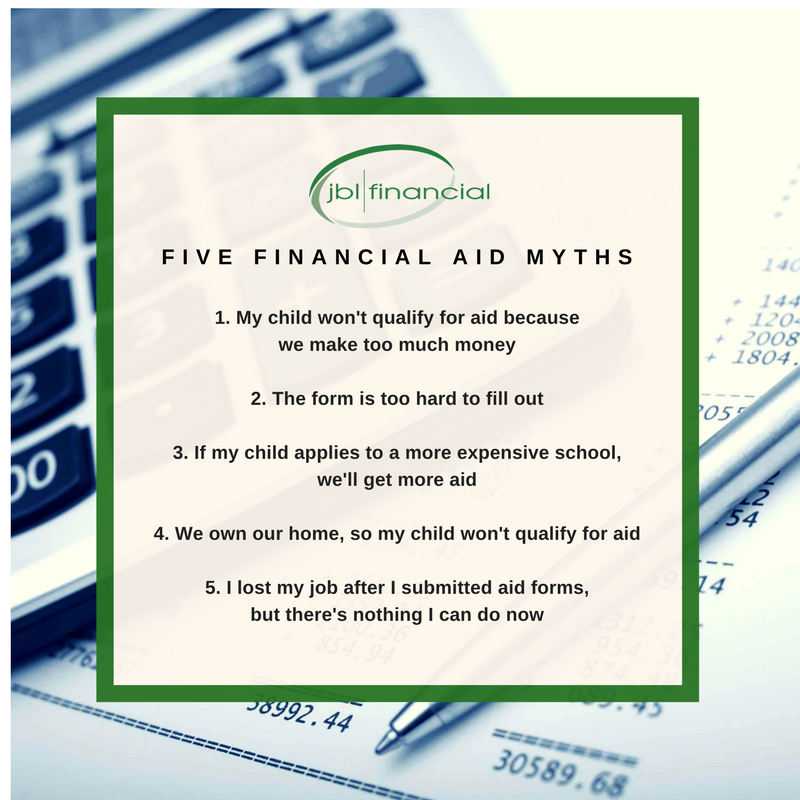With some private colleges now crossing the once unthinkable $70,000-per-year mark in the 2017/2018 school year, and higher costs at public colleges, too, financial aid is essential for many families. How much do you know about this important piece of the college financing puzzle? Consider these financial aid myths.
My child won't qualify for aid because we make too much money
Not necessarily. While it's true that family income is the main factor in determining aid eligibility, it's not the only factor. The number of children you'll have in college at the same time is a significant factor — for example, having two children in college will cut your expected family contribution (EFC) in half. Your assets, overall family size, and age of the older parent also play into the equation.
Side note: Even if you think your child won't qualify for aid, you should still consider filing the government's Free Application for Federal Student Aid (FAFSA) for two reasons. First, all students — regardless of income — who attend school at least half-time are eligible for unsubsidized federal Direct Loans, and the FAFSA is a prerequisite for these loans. ("Unsubsidized" means the student pays the interest during college, the grace period, and any loan deferment periods.) So if you want your child to have some "skin in the game" by taking on a small student loan, you'll need to file the FAFSA. Second, the FAFSA is always a prerequisite for college need-based aid and is sometimes a prerequisite for college merit-based aid. Bottom line? It's usually a good idea to file this form.
The form is too hard to fill out
Not really. Years ago, the FAFSA was cumbersome to fill out. But now that it's online at fafsa.ed.gov, it is much easier to complete. The  online version has detailed instructions and guides you step by step. There is also a toll-free number you can call with questions: 1-800-4-FED-AID. All advice is free. In addition, a recent change has made the FAFSA even easer to fill out: The FASFA now relies on your tax information from two years prior rather than one year prior (referred to as the "prior-prior year" or the "base year"). For example, the 2017/2018 FAFSA relies on your 2015 tax information, the 2018/2019 FAFSA relies on your 2016 tax information, and so on. This means that your necessary tax numbers will be handy as you answer questions on the FAFSA. The first time you file the FAFSA, you and your child will need to create an FSA ID, which consists of a username and password.
online version has detailed instructions and guides you step by step. There is also a toll-free number you can call with questions: 1-800-4-FED-AID. All advice is free. In addition, a recent change has made the FAFSA even easer to fill out: The FASFA now relies on your tax information from two years prior rather than one year prior (referred to as the "prior-prior year" or the "base year"). For example, the 2017/2018 FAFSA relies on your 2015 tax information, the 2018/2019 FAFSA relies on your 2016 tax information, and so on. This means that your necessary tax numbers will be handy as you answer questions on the FAFSA. The first time you file the FAFSA, you and your child will need to create an FSA ID, which consists of a username and password.
Side note: The CSS/Financial Aid PROFILE, an additional aid form required by most private colleges, is more detailed than the FAFSA and thus harder to fill out. It essentially takes a financial snapshot of your family's past year, current year, and upcoming year (it asks for estimates for the latter).
If my child applies to a more expensive school, we'll get more aid
Not necessarily. Colleges determine your EFC based on the income and asset information you provide on the FAFSA and, where applicable, the CSS PROFILE. Your EFC stays the same no matter what college your child applies to. The difference between the cost of a particular college and your EFC equals your child's financial need (sometimes referred to as "demonstrated need"). The more expensive a college is, the greater your child's financial need. But a greater financial need doesn't automatically translate into a bigger financial aid package — colleges aren't obligated to meet 100% of your child's financial need.
Side note: When making a college list, your child can research a particular college's generosity, including whether it meets 100% of demonstrated need and if it replaces federal loan awards with college grants in its aid packages.
We own our home, so my child won't qualify for aid
The FAFSA does not take home equity into account when determining a family's expected family contribution (it also does not consider the value of retirement accounts, cash value life insurance, and annuities).
Side note: The CSS PROFILE does collect home equity and vacation home information, and some colleges may use it when distributing their own institutional aid.
I lost my job after I submitted aid forms, but there's nothing I can do now
Not true. If your financial circumstances change after you file the FAFSA — and you can support this with documentation — you can politely ask the financial aid officer at your child's school to revisit your aid package; the officer has the authority to make adjustments if there have been material changes to your family's income or assets.
Side note: A blanket statement of "I can't afford my family contribution" is unlikely to be successful unless it is accompanied by a significant changed circumstance that affects your ability to pay.
This article was prepared by Broadridge Financial Solutions.



.png)
